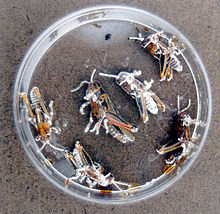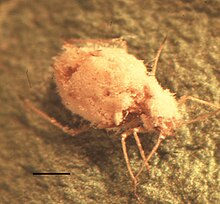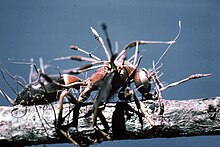Entomopathogenic fungus
This article has multiple issues. Please help or discuss these issues on the talk page. (Learn how and when to remove these template messages)
|
An entomopathogenic fungus is a fungus that can act as a parasite of insects and kills or seriously disables them.

Typical life cycle[]

These fungi usually attach to the external body surface of insects in the form of microscopic spores (usually asexual, mitosporic spores also called conidia). Under the right conditions of temperature and (usually high) humidity, these spores germinate, grow as hyphae and colonize the insect's cuticle; which they bore through by way of enzymatic hydrolysis, reaching the insects' body cavity (hemocoel).[1] Then, the fungal cells proliferate in the host body cavity, usually as walled hyphae or in the form of wall-less protoplasts (depending on the fungus involved). After some time the insect is usually killed (sometimes by fungal toxins), and new propagules (spores) are formed in or on the insect if environmental conditions are again right. High humidity is usually required for sporulation.
Groups[]

The entomopathogenic fungi include taxa from several of the main fungal groups and do not form a monophyletic group. Many common and/or important entomopathogenic fungi are in the order Hypocreales of the Ascomycota: the asexual (anamorph) phases Beauveria, Isaria (was Paecilomyces), Hirsutella, Metarhizium, Nomuraea and the sexual (teleomorph) state Cordyceps; others (Entomophthora, Zoophthora, Pandora, Entomophaga) belong in the order Entomophthorales of the Zygomycota.
Related fungi attack and kill other invertebrates (e.g. nematodes).
Pest control[]
Since they are considered natural mortality agents and environmentally safe, there is worldwide interest in the use and manipulation of entomopathogenic fungi for biological control of insects and other arthropod pests. In particular, the asexual phases of Ascomycota (Beauveria spp., Isaria spp., Lecanicillium spp., Metarhizium spp., Purpureocillium spp. and others) are under intense scrutiny due to traits favouring their use as biological insecticides.[2] The development of entomopathogens as pesticides depends on research into their host specificity, stability, formulation, and methods of application.
Production[]
Most entomopathogenic fungi can be grown on artificial media. However, some require extremely complex media; others, like Beauveria bassiana and exploitable species in the genus Metarhizium, can be grown on starch-rich substrates like cereal grains (rice, wheat).
Virulence[]
The Entomophthorales are often reported as causing high levels of mortality (epizootics) in nature. These fungi are highly virulent. The anamorphic Ascomycota (Metarhizium, Beauveria etc.) are reported as causing epizootics less frequently in nature.
Host Relationship Chemical Cues[]
Entomopathogenic fungi like Beauveria bassiana and Metarhizium anisopliae successfully infect susceptible host populations through conidia[3] [4] There is continued research to determine the signaling cues between these fungi and their host targets. After all, the ability to sense these parasites can increase fitness for the host targets. There is evidence that the signal recognition occurs within some hosts, but not others. For example, the ectoparasitoid Cephalonomia tarsalis is susceptible to B. bassiana but it cannot detect the presence of free conidia of this fungus or living hosts that were infected by the fungus.[5] Because they cannot detect these parasites, either the host or the host's offspring become infected and/or die. In contrast, termites are able to detect and avoid some lethal strains of conidia.[6] Furthermore, other soil-dwelling insects have evolved the ability to detect and avoid certain entomopathogenic fungi.[citation needed]
See also[]
- Biological insecticides
- Entomopathogenic nematode
- LUBILOSA and the desert locust pages for more on use of Metarhizium as a biological insecticide.
References[]
- ^ Fernandes EG, Valério HM, Feltrin T, Van Der Sand ST (2012). "Variability in the production of extracellular enzymes by entomopathogenic fungi grown on different substrates". Braz. J. Microbiol. 43 (2): 827–33. doi:10.1590/S1517-83822012000200049. PMC 3768820. PMID 24031896.
- ^ Strasser H, Vey A, Butt TM (28 June 2010). "Are There any Risks in Using Entomopathogenic Fungi for Pest Control, with Particular Reference to the Bioactive Metabolites of Metarhizium, Tolypocladium and Beauveria species?". Biocontrol Science and Technology. 10 (6): 717–735. doi:10.1080/09583150020011690.
- ^ Vandenburg, J.D., Ramos, M. & Altre, J.A. (1998) Dose –response and age- and temperature-related susceptibility of the diamondback moth (Lepidoptera: Plutellidae) to two isolates of Beauveria bassiana (Hyphomycetes: Moniliaceae). Environmental Entomology, 27, 1017–1021.
- ^ Hughes, W.O.H., Petersen, K.S., Ugelvig, L.V., Pedersen, D., Thomsen, L., Poulsen, M. et al. (2004) Density-dependence and within-host competition in a semelparous parasite of leafcutting ants. BMC Evolutionary Biology, 4, 45.
- ^ Lord, J.C. (2001) Response of the wasp Cephalonomia tarsalis (Hymenoptera: Bethylidae) to Beauveria bassiana(Hyphomycetes: Moniliales) as free conidia or infection in its host, the sawtoothed grain beetle, Oryzaephilus surinamensis (Coleoptera: Silvanidae). Biological Control, 21,300–304.
- ^ Myles, T.G. (2002) Alarm, aggregation, and defense by Reticulitermes flavipes in response to a naturally occurring isolate of Metarhizium anisopliae. Sociobiology, 40, 243–255.
External links[]
- Entomopathogens and microbial control, from the University of Warwick
- Insect mycology, by Dr. Richard A. Humber
- USDA-ARS Collection of Entomopathogenic Fungi
- Entomopathogenic Fungi as Effective Insect Pest Management Tactic: A Review, by Hafiza Tahira Gul
- Animal fungal diseases
- Insect ecology
- Parasites of insects